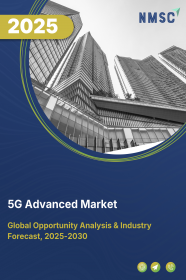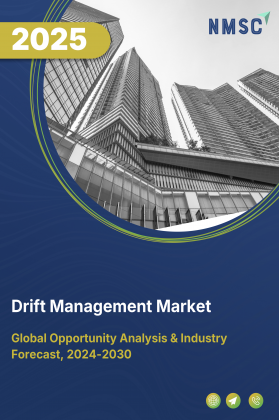
5G Advanced Market Size by Component (Base Stations, Antennas, Routers, and Switches), by Network Infrastructure (Radio Access Network (RAN), Core Network, and Transport Network), by Deployment Type (Standalone (SA) and Non-Standalone (NSA) Mode), by Application (Autonomous Vehicles, Smart Cities, Augmented Reality/Virtual Reality, and Industrial Automation) and Others– Global Opportunity Analysis and Industry Forecast 2025-2030.
Market Definition
The 5G Advanced Market size was valued at USD 17.17 billion in 2024 and is predicted to reach USD 450.79 billion by 2030 with a CAGR of 72.4% from 2025 to 2030.
5G Advanced, also known as 5G-A, is the next evolution of 5G wireless technology. It is a set of enhancements and upgrades to the original 5G specifications that were defined by the 3rd Generation Partnership Project (3GPP). The key features of 5G Advanced include higher data rates, lower latency, improved reliability, and greater capacity.
It also includes advanced techniques such as carrier aggregation, massive MIMO (Multiple Input Multiple Output), and beamforming to improve spectral efficiency and network performance. 5G Advanced is being developed to meet the growing demand for high-speed, low-latency wireless connectivity and to support emerging applications such as autonomous vehicles, virtual and augmented reality, and smart cities.
Market Dynamics and Trends
The demand for 5G advanced is rising driven by the increasing popularity of mobile video and streaming services such as Netflix, YouTube, and Amazon Prime Video, necessitating high-speed, low-latency networks to ensure consistent quality of service.
Moreover, the integration of 5G technology in the e-commerce and retail sector enhances customer connectivity, leading to increased sales and improved inventory management efficiencies. According to the Shopify, the global e-commerce industry size is expected to reach USD 58,740 billion by 2028, with the CAGR of 26.5%.
Furthermore, the growing number of IoT devices, there is a need for 5G Advanced networks to support massive machine-type communication (mMTC) and ultra-reliable low-latency communication (URLLC) for real-time control and monitoring of these devices, which in turn fuels the growth of the market. According to the IoT Analytics, the number of global IoT connections grew by 18% in 2022 to 14.3 billion active IoT endpoints and there will be 29 billion IoT connections by 2027.
However, the deployment of 5G technology requires significant investments in infrastructure, that acts as a financial burden for small and medium size industries, thus restraining the growth of the market. On the contrary, the introduction of massive MIMO (Multiple-Input Multiple-Output) technology is expected to create ample growth opportunities for the market in the future. As it uses a large number of antennas to increase the capacity and speed of wireless communication systems.
Market Segmentation and Scope of Study
The global 5G Advanced market is segmented on the basis of component, network infrastructure, deployment type, application, industry vertical and Region. Based on component, the market is classified into base stations, antennas, routers, and switches. Based on network infrastructure, the market is bifurcated into radio access network (RAN), core network, and transport network. Based on the deployment type, the market is segmented into standalone (SA) mode and non-standalone (NSA) mode. Based on application, the market is categorized into, autonomous vehicles, smart cities, augmented reality/virtual reality, and industrial automation. On the basis of industry vertical, the market is segmented into, healthcare, automotive, manufacturing, energy & utilities, retail, and others. Regional breakdown and analysis of each of the aforesaid classifications include regions comprising North America, Europe, Asia-Pacific, and RoW.
Geographical Analysis
Asia-Pacific dominated the global 5G Advanced market and is potently expected to remain dominant in the market throughout the forecast period. This is attributed to the growing smartphone industry in countries such as China, Japan, and India. The 5G advanced technology is becoming increasingly popular in the smartphone industry due to their ability to demand faster download and upload speeds, lower latency, and more reliable connectivity.
According to the China Academy of Information and Communications Technology (CAICT), the total consignment of 5G mobile phones in China was 26.17 million units in 2024, which is marking a 59% year-on-year expansion.
Moreover, favorable government initiatives and policies supporting 5G deployment drive regional dominance in the global 5G Advanced market, with a focus on building smart cities and digital infrastructure leading to increased investment in 5G technology.
For instance, China's Digital Silk Road (DSR) initiative aims to advance smart city development by collaborating on telecommunication networks, AI, cloud computing, e-commerce, and other advanced digital technologies, showcasing the country's commitment to digital infrastructure advancement.
North America is projected to exhibit substantial growth in the global 5G Advanced market owing to the surge in the online gaming industry, driven by the technology's faster data speeds and lower latency, enhancing the gaming experience for users.
According to the American Gaming Association (AGA), the commercial gaming revenue reached USD 60.42 billion in 2022, which is a 13.9% increase over 2021 and 38.5% higher than in 2019. Moreover, the adoption of 5G technology in North America's healthcare industry enables improved patient care through remote monitoring, telemedicine, and real-time data analysis, resulting in better health outcomes and driving growth in the 5G Advanced market. According to the Centers for Medicare & Medicaid Services, the U.S. spent USD 4.5 trillion on healthcare in 2022, a 4.1% increase. Which makes USD 13,493 per person and accounts for 17.3% of the GDP.
Competitive Landscape
The 5G Advanced market includes several market players such asTelefonaktiebolaget LM Ericsson, Huawei Technologies Co., Ltd., Nokia Corporation, Samsung Electronics Co Ltd., Qualcomm Technologies Inc., AT&T Inc., Verizon, MediaTek Inc., Cisco Systems, Inc., ZTE Corporation, Tejas Networks, Netscout Systems, Inc., NEC Corporation, CommScope, Airspan among others. These market players are adopting various strategies such as innovation and collaboration to maintain their dominance in the global 5G advanced market.
For instance, in February 2023, Nokia, Qualcomm Technologies, Inc., and T-Mobile announced the world’s first aggregating 5G Standalone (SA) spectrum using 5CC Carrier Aggregation (5CC CA) in a sub-6 GHz spectrum. This development allows faster 5G download and upload speeds for T-Mobile customers in the United States, particularly in rural areas. This collaboration between Nokia, Qualcomm, and T-Mobile demonstrates the potential for continued growth and innovation in the 5G industry.
Also, in February 2023, Ericsson and Telia launched new 5G innovation program in Sweden for enterprises to provide a platform for businesses to develop and test 5G use cases and solutions, leveraging the high-speed and low-latency capabilities of 5G networks. This collaboration is expected to boost the development and adoption of 5G advanced technology in Sweden, helping the country gain a competitive edge in the global market.
Key Market Segments
By Component
-
Base Stations
-
Antennas
-
Routers
-
Switches
By Network Infrastructure
-
Radio Access Network (RAN)
-
Core Network
-
Transport Network
By Deployment Type
-
Standalone (SA) Mode
-
Non-Standalone (NSA) Mode
By Application
-
Autonomous Vehicles
-
Smart Cities
-
Augmented Reality/Virtual Reality
-
Industrial Automation
By Industry vertical
-
Healthcare
-
Automotive
-
Manufacturing
-
Energy & Utilities
-
Retail
-
Others
By Region
-
North America
-
The U.S
-
Canada
-
Mexico
-
-
Europe
-
The UK
-
Germany
-
France
-
Italy
-
Spain
-
Denmark
-
Netherlands
-
Finland
-
Sweden
-
Norway
-
Russia
-
Rest of Europe
-
-
Asia-Pacific
-
China
-
Japan
-
India
-
South Korea
-
Australia
-
Indonesia
-
Singapore
-
Taiwan
-
Thailand
-
Rest of Asia-Pacific
-
-
RoW
-
Latin America
-
Middle East
-
Africa
-
Key Players
-
Telefonaktiebolaget LM Ericsson
-
Huawei Technologies Co., Ltd.
-
Nokia Corporation
-
Samsung Electronics Co Ltd.
-
Qualcomm Technologies Inc.
-
AT&T Inc.
-
Verizon
-
MediaTek Inc.
-
Cisco Systems, Inc.
-
ZTE Corporation
-
Tejas Networks
-
Netscout Systems, Inc.
-
NEC Corporation
-
CommScope
-
Airspan
REPORT SCOPE AND SEGMENTATION:
|
Parameters |
Details |
|
Market Size in 2024 |
USD 17.17 billion |
|
Revenue Forecast in 2030 |
USD 450.79 billion |
|
Growth Rate |
CAGR of 72.4% from 2025 to 2030 |
|
Analysis Period |
2024–2030 |
|
Base Year Considered |
2024 |
|
Forecast Period |
2025–2030 |
|
Market Size Estimation |
Billion (USD) |
|
Growth Factors |
|
|
Countries Covered |
28 |
|
Companies Profiled |
15 |
|
Market Share |
Available for 10 companies |
|
Customization Scope |
Free customization (equivalent up to 80 working hours of analysts) after purchase. Addition or alteration to country, regional, and segment scope. |
|
Pricing and Purchase Options |
Avail customized purchase options to meet your exact research needs. |




















 Speak to Our Analyst
Speak to Our Analyst

























